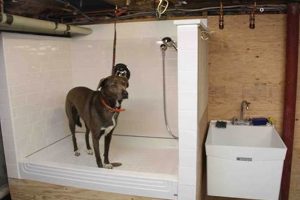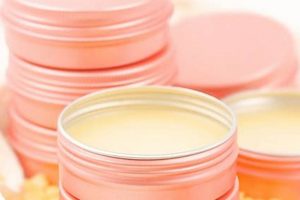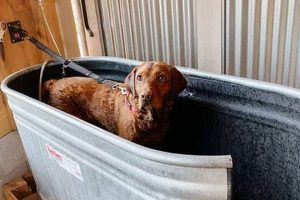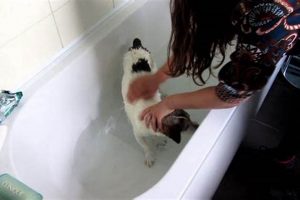Constructing an enclosure for a canine companion from readily available materials provides a custom-fit space. This approach allows owners to tailor the dimensions, style, and features of the structure to meet their pet’s specific needs and the surrounding environment’s aesthetic. For example, reclaimed wood could be repurposed into a stylish and functional haven.
The advantages of this personalized approach are multifaceted. It offers significant cost savings compared to commercially manufactured alternatives. Furthermore, it encourages resourcefulness and repurposing, contributing to sustainable practices. Historically, crafting animal enclosures was a common practice driven by necessity and resource availability, a tradition that continues today with a focus on customization and design.
The subsequent sections will delve into the essential considerations for design, material selection, and construction techniques. Emphasis will be placed on ensuring the finished product is safe, durable, and comfortable for the animal. Furthermore, various design ideas and customization options will be presented to inspire creativity and functionality.
Construction Guidance
This section offers essential guidelines for ensuring the creation of a safe and functional enclosure. Adhering to these points will maximize the longevity and utility of the structure.
Tip 1: Material Selection: Prioritize non-toxic materials. Untreated wood and pet-safe sealants are recommended to prevent ingestion of harmful chemicals.
Tip 2: Structural Integrity: Reinforce all joints and connections. Utilize screws and wood glue to create strong and stable corners and seams.
Tip 3: Ventilation: Incorporate adequate airflow. Install wire mesh or strategically placed openings to prevent stagnant air and maintain a comfortable internal environment.
Tip 4: Secure Latch Mechanism: Employ a reliable locking system. Consider a two-point latch or a carabiner-style closure to prevent accidental escapes.
Tip 5: Smooth Surfaces: Sand down any rough edges or splinters. This minimizes the risk of injury and ensures the animal’s comfort.
Tip 6: Consider Size: Ensure adequate space. The animal should be able to stand, turn around, and lie down comfortably within the enclosure.
Tip 7: Durability Assessment: Inspect the finished structure thoroughly. Test the stability of all components before introducing the animal to the space.
By adhering to these guidelines, a secure and comfortable space can be created. Careful consideration of materials, construction, and safety measures will contribute to the project’s success.
The following section will cover advanced construction techniques and potential customization options for enhancing the build.
1. Appropriate dimensions
Establishing appropriate dimensions for a self-constructed canine enclosure is paramount for both the animal’s welfare and the practical functionality of the structure. Overlooking this aspect can compromise safety, comfort, and the overall success of the project.
- Canine Size and Breed Considerations
The intended occupant’s size and breed dictate the minimum internal dimensions. A Great Dane requires significantly more space than a Chihuahua. Breed-specific conformational traits, such as a Greyhound’s long limbs, should also be considered to ensure comfortable standing and stretching.
- Adequate Headroom and Turning Radius
The animal must be able to stand upright without its head touching the top of the enclosure. Furthermore, it must possess sufficient room to turn around freely and lie down in a comfortable position without contorting its body. Insufficient headroom or turning space can lead to physical discomfort and behavioral issues.
- Growth Potential (for Puppies)
When constructing an enclosure for a puppy, anticipated growth must be factored into the dimensional calculations. Building an enclosure that only accommodates the puppy’s current size will necessitate a larger structure later. Consider the fully grown size of the breed to avoid future reconstruction.
- Practicality and Space Constraints
While prioritizing the animal’s needs, the practicality of the enclosure’s dimensions within the intended environment must also be considered. A structure that is excessively large may be impractical for the available space within the home or vehicle. Balance must be struck between the animal’s comfort and spatial limitations.
Therefore, careful consideration of canine size, breed, growth potential, and spatial constraints is essential when determining the appropriate dimensions. Accurate measurements and thoughtful planning are fundamental to creating a safe, comfortable, and functional structure.
2. Material safety
The selection of materials directly impacts the overall safety and well-being of a canine occupying a self-constructed enclosure. Improper choices can introduce hazards, potentially causing illness or injury. The causal relationship is clear: unsafe materials result in an unsafe environment. For instance, using treated lumber, commonly pressure-treated with chemicals to resist decay, poses a significant risk. If ingested, these chemicals can lead to poisoning. Therefore, understanding the composition and potential toxicity of materials is paramount in creating a safe and healthy space.
Furthermore, the practical implications of material selection extend to the long-term durability and maintenance of the enclosure. While certain materials may seem cost-effective initially, their susceptibility to damage from chewing or exposure to the elements can necessitate frequent repairs or replacement. This, in turn, can expose the animal to further risks, such as splinters from damaged wood or corrosion from rusting metal. The use of non-toxic, durable materials, like untreated hardwoods or pet-safe plastics, ensures both the structural integrity and safety of the structure over an extended period. For example, hardwoods that are naturally resistant to moisture and decay and are sealed with a non-toxic finish contribute to a safe and durable construction.
In summary, ensuring material safety is not merely a desirable attribute, but a fundamental requirement for any self-constructed enclosure. The risks associated with using inappropriate or toxic materials far outweigh any potential cost savings or convenience. Selecting materials with both safety and durability in mind mitigates potential hazards, promotes the animal’s well-being, and ensures the longevity of the structure. Addressing this critical component upfront leads to a safer outcome.
3. Structural Integrity
Structural integrity is a foundational requirement in the creation of a “diy crate for dog.” The enclosure’s ability to withstand applied forces, resist deformation, and maintain its intended shape directly correlates with the safety and security of the animal housed within. Insufficient structural integrity can lead to catastrophic failure, resulting in potential injury or escape. The underlying cause is often inadequate design or improper construction techniques. A direct effect of neglecting this element is a compromised structure that is inherently unsafe.
The importance of structural integrity can be observed in various real-world scenarios. For example, a poorly constructed wooden enclosure with weak joints may collapse under the animal’s weight or through normal wear and tear. Similarly, a wire enclosure with inadequate gauge wire or poorly welded connections is susceptible to breakage, creating sharp edges and potential escape routes. A structurally sound enclosure, conversely, provides a secure and stable environment, minimizing the risk of injury and offering peace of mind to the owner. The practical significance lies in the direct correlation between construction quality and the well-being of the animal. It is related with the longevity of structure itself. The design need to be correct to guarantee longetivity of “diy crate for dog”
In conclusion, structural integrity is not merely an abstract concept but a critical and tangible attribute of any “diy crate for dog.” Addressing design flaws, selecting appropriate materials, and employing robust construction methods are essential for ensuring the enclosure’s stability and safety. The challenges associated with achieving optimal structural integrity underscore the need for careful planning, meticulous execution, and a thorough understanding of basic engineering principles. Prioritizing this facet of construction directly contributes to the animal’s safety, comfort, and overall well-being, and is linked to the broader theme of responsible pet ownership.
4. Ventilation design
Ventilation design, within the context of a self-constructed canine enclosure, constitutes a critical element directly impacting the animal’s health and comfort. Insufficient airflow can lead to a build-up of stale air, odors, and potentially harmful levels of humidity. This creates a breeding ground for bacteria and mold, increasing the risk of respiratory issues and other health problems. The underlying causal mechanism is the inadequate exchange of air, leading to a stagnant internal environment. A direct result of poor ventilation is a compromised living space for the animal.
The importance of adequate ventilation is exemplified in various scenarios. During warmer months, poor airflow can contribute to overheating and heatstroke, particularly in brachycephalic breeds (e.g., Bulldogs, Pugs) that are more susceptible to respiratory distress. Conversely, in colder months, insufficient ventilation coupled with inadequate insulation can lead to a build-up of condensation, creating a damp and uncomfortable environment. Practical application dictates that ventilation openings should be strategically placed to maximize cross-ventilation without creating drafts. Examples include incorporating mesh panels on multiple sides or integrating adjustable vents to regulate airflow based on ambient conditions. The consideration must include the animal’s direct environment. Air that isn’t ventilated properly is dangerous to both human and animal.
In summary, appropriate ventilation design is not an ancillary consideration but a fundamental requirement for any self-constructed canine enclosure. The risks associated with poor airflow, including health complications and discomfort, underscore the necessity of careful planning and execution. Addressing the design early mitigates potential hazards, promotes the animal’s well-being, and ensures a more hygienic and comfortable environment. This crucial factor is inextricably linked to responsible ownership.
5. Secure closure
A secure closure mechanism is a non-negotiable element in the design and construction of a “diy crate for dog.” Its primary function is to prevent unauthorized egress of the animal, ensuring safety and containment. The efficacy of this component directly influences the overall functionality and value of the enclosure.
- Latch Mechanism Design
The latch mechanism must be robust and resistant to manipulation by the animal. Simple hook-and-eye closures are generally insufficient, as they can be easily dislodged. Preferred designs incorporate a multi-point locking system or a rotating latch with a positive engagement. For instance, a spring-loaded bolt that requires deliberate action to disengage offers a higher level of security. The mechanism needs to be constructed to be secure and functional at the same time.
- Material Durability
The materials used in the closure mechanism must be durable enough to withstand repeated use and potential chewing or scratching by the animal. Lightweight plastics are prone to breakage, while heavy-gauge metal provides greater resistance to damage. Stainless steel is an ideal choice due to its corrosion resistance and strength. The material being used affect the overall life cycle of “diy crate for dog”.
- Accessibility for the Owner
While prioritizing security, the closure mechanism must also be readily accessible and easily operable by the owner. Complex or cumbersome designs can be frustrating to use, potentially leading to the mechanism being left unsecured. A balance must be struck between security and user-friendliness. Ease of usage is important factor for many user.
- Placement and Reinforcement
The placement of the closure mechanism on the enclosure is crucial. It should be positioned in a location that is difficult for the animal to reach or manipulate. Reinforcing the surrounding area with additional material can prevent the animal from forcing the door or gate open. For example, metal bracing around the latch can significantly enhance its security. Having an effective placement is important for keeping the structure robust.
In conclusion, the secure closure is more than a simple latch; it is a critical safety component that directly impacts the well-being of the animal and the peace of mind of the owner. A well-designed and properly implemented closure mechanism minimizes the risk of escape, ensuring the “diy crate for dog” fulfills its intended purpose. A reliable lock provides the safetiness for animal and owner.
6. Ease of cleaning
The attribute of ease of cleaning is a critical, yet often underestimated, factor in the design and construction of a “diy crate for dog.” The direct causal link between a clean enclosure and an animal’s health and well-being is undeniable. A “diy crate for dog” that is difficult to clean fosters an environment conducive to bacterial growth, parasitic infestations, and the accumulation of allergens. These conditions can lead to a range of health problems, from skin irritations to respiratory ailments. The fundamental principle is that a clean living space directly promotes a healthier animal.
Practical application of this concept translates into several key design considerations. For instance, selecting materials that are non-porous and resistant to staining is crucial. Smooth, sealed surfaces are easier to wipe down and disinfect than textured or absorbent materials. Designing a “diy crate for dog” with a removable floor pan facilitates the easy removal of waste and debris. Furthermore, incorporating features such as rounded corners and minimal crevices prevents the accumulation of dirt and grime. An example of this is a custom wooden crate treated with a pet-safe, waterproof sealant, coupled with a durable, removable plastic tray for waste collection.
In conclusion, integrating ease of cleaning into the design of a “diy crate for dog” is not merely a matter of convenience, but a fundamental aspect of responsible pet ownership. The challenges associated with maintaining a hygienic environment necessitate a proactive approach to design and material selection. By prioritizing ease of cleaning, the creator is actively contributing to the animal’s health, comfort, and overall quality of life. A “diy crate for dog” with design of ease of cleaning will benefit the owner and the pet.
7. Portability (if needed)
Portability, while not a universal requirement, represents a significant design consideration for a self-constructed canine enclosure. The necessity of transportability is contingent upon the owner’s lifestyle and the intended use of the structure. The absence of portability in a stationary environment is inconsequential, but its presence becomes paramount when frequent relocation is anticipated.
- Collapsible or Modular Design
Achieving portability often necessitates a collapsible or modular design. This approach allows the enclosure to be disassembled into smaller, more manageable components for transportation and storage. Connections should be secure yet easily disengaged, utilizing robust latches or quick-release mechanisms. For example, a wooden crate with hinged sides and removable panels can be folded flat when not in use. The portability of the crate need to be effective for transportability.
- Weight Considerations
The overall weight of the enclosure directly affects its ease of transport. Utilizing lightweight materials, such as aluminum framing or thin-gauge plywood, can significantly reduce the burden. However, weight reduction must be balanced against structural integrity. Reinforcements may be necessary to compensate for the reduced material thickness. Weight is an important aspect to consider when using “diy crate for dog”.
- Integrated Handles or Wheels
Incorporating integrated handles or wheels facilitates easier maneuvering. Handles should be ergonomically designed and securely attached to the structure. Wheels, preferably locking casters, provide mobility on smooth surfaces. The placement of handles and wheels should be carefully considered to ensure balanced weight distribution. Adding the Wheels for easier transport can ease the load of the owner.
- Durability of Moving Components
Moving components, such as hinges, latches, and wheels, are subject to increased wear and tear. Selecting high-quality, durable hardware is essential for ensuring the longevity and reliability of the portable enclosure. Regular maintenance, including lubrication and tightening of fasteners, is necessary to prevent premature failure. Moving parts need to be durable for safety assurance.
In summary, the incorporation of portability into a “diy crate for dog” requires careful planning and execution. Design decisions must balance the competing demands of weight, structural integrity, durability, and ease of use. A well-designed portable enclosure provides a convenient and safe solution for transporting the animal while maintaining a familiar and comfortable environment. The design should be made according the user needs.
Frequently Asked Questions
This section addresses common inquiries and clarifies misconceptions regarding the construction and utilization of self-made canine enclosures.
Question 1: What are the primary safety concerns when constructing a “diy crate for dog”?
Material toxicity, structural instability, and inadequate ventilation represent the foremost safety considerations. Non-toxic materials prevent poisoning, structural integrity mitigates collapse risk, and sufficient airflow prevents respiratory distress.
Question 2: Is it more cost-effective to build a “diy crate for dog” compared to purchasing a commercially manufactured one?
Cost savings are often realized through self-construction, particularly when utilizing reclaimed or repurposed materials. However, the value of labor and the expense of specialized tools must be factored into the overall equation. Sourcing materials at reasonable prices are important for cost reduction.
Question 3: What types of materials are best suited for building a durable “diy crate for dog”?
Untreated hardwoods, such as oak or maple, offer excellent durability and resistance to chewing. Heavy-gauge wire mesh provides secure containment while maintaining ventilation. Pet-safe sealants protect wood from moisture and damage.
Question 4: How can proper ventilation be ensured in a “diy crate for dog”?
Ventilation can be maximized by incorporating strategically placed openings on multiple sides of the enclosure. Wire mesh panels, adjustable vents, or a combination of both can facilitate adequate airflow without creating drafts.
Question 5: What is the recommended method for cleaning a “diy crate for dog”?
Removable floor pans and smooth, sealed surfaces simplify the cleaning process. Regular wiping with a pet-safe disinfectant solution is recommended to maintain a hygienic environment.
Question 6: How does one determine the appropriate dimensions for a “diy crate for dog”?
The dimensions should accommodate the animal’s ability to stand, turn around, and lie down comfortably. Breed-specific conformational traits and growth potential (for puppies) must also be considered. It need to adjust according to the species.
In summary, the successful construction and utilization of a “diy crate for dog” requires careful attention to safety, material selection, ventilation, cleaning, and dimensional considerations. Failure to address these critical factors can compromise the animal’s well-being and the overall functionality of the structure.
The next section will provide illustrative examples of successful “diy crate for dog” projects.
Conclusion
The preceding discourse has explored the multifaceted considerations involved in the construction of a “diy crate for dog.” The importance of material selection, structural integrity, ventilation design, secure closure mechanisms, ease of cleaning, and, when applicable, portability has been emphasized. A thorough understanding of these elements is paramount to ensure the safety, comfort, and well-being of the animal housed within. Neglecting any of these aspects can lead to adverse consequences, ranging from minor discomfort to serious health risks.
The endeavor of creating a suitable enclosure demands diligence, informed decision-making, and a commitment to responsible pet ownership. The information presented serves as a foundational guide for individuals seeking to construct a “diy crate for dog” that is both functional and safe. Further research and consultation with experts may be warranted, depending on the specific design and materials chosen. The ultimate goal remains the provision of a secure and comfortable space that promotes the health and happiness of the canine companion.







